Zhiwen Zuo
Fine-Grained Controllable Apparel Showcase Image Generation via Garment-Centric Outpainting
Mar 03, 2025Abstract:In this paper, we propose a novel garment-centric outpainting (GCO) framework based on the latent diffusion model (LDM) for fine-grained controllable apparel showcase image generation. The proposed framework aims at customizing a fashion model wearing a given garment via text prompts and facial images. Different from existing methods, our framework takes a garment image segmented from a dressed mannequin or a person as the input, eliminating the need for learning cloth deformation and ensuring faithful preservation of garment details. The proposed framework consists of two stages. In the first stage, we introduce a garment-adaptive pose prediction model that generates diverse poses given the garment. Then, in the next stage, we generate apparel showcase images, conditioned on the garment and the predicted poses, along with specified text prompts and facial images. Notably, a multi-scale appearance customization module (MS-ACM) is designed to allow both overall and fine-grained text-based control over the generated model's appearance. Moreover, we leverage a lightweight feature fusion operation without introducing any extra encoders or modules to integrate multiple conditions, which is more efficient. Extensive experiments validate the superior performance of our framework compared to state-of-the-art methods.
Rethink Arbitrary Style Transfer with Transformer and Contrastive Learning
Apr 21, 2024



Abstract:Arbitrary style transfer holds widespread attention in research and boasts numerous practical applications. The existing methods, which either employ cross-attention to incorporate deep style attributes into content attributes or use adaptive normalization to adjust content features, fail to generate high-quality stylized images. In this paper, we introduce an innovative technique to improve the quality of stylized images. Firstly, we propose Style Consistency Instance Normalization (SCIN), a method to refine the alignment between content and style features. In addition, we have developed an Instance-based Contrastive Learning (ICL) approach designed to understand the relationships among various styles, thereby enhancing the quality of the resulting stylized images. Recognizing that VGG networks are more adept at extracting classification features and need to be better suited for capturing style features, we have also introduced the Perception Encoder (PE) to capture style features. Extensive experiments demonstrate that our proposed method generates high-quality stylized images and effectively prevents artifacts compared with the existing state-of-the-art methods.
Generative Image Inpainting with Segmentation Confusion Adversarial Training and Contrastive Learning
Mar 23, 2023



Abstract:This paper presents a new adversarial training framework for image inpainting with segmentation confusion adversarial training (SCAT) and contrastive learning. SCAT plays an adversarial game between an inpainting generator and a segmentation network, which provides pixel-level local training signals and can adapt to images with free-form holes. By combining SCAT with standard global adversarial training, the new adversarial training framework exhibits the following three advantages simultaneously: (1) the global consistency of the repaired image, (2) the local fine texture details of the repaired image, and (3) the flexibility of handling images with free-form holes. Moreover, we propose the textural and semantic contrastive learning losses to stabilize and improve our inpainting model's training by exploiting the feature representation space of the discriminator, in which the inpainting images are pulled closer to the ground truth images but pushed farther from the corrupted images. The proposed contrastive losses better guide the repaired images to move from the corrupted image data points to the real image data points in the feature representation space, resulting in more realistic completed images. We conduct extensive experiments on two benchmark datasets, demonstrating our model's effectiveness and superiority both qualitatively and quantitatively.
MicroAST: Towards Super-Fast Ultra-Resolution Arbitrary Style Transfer
Nov 28, 2022
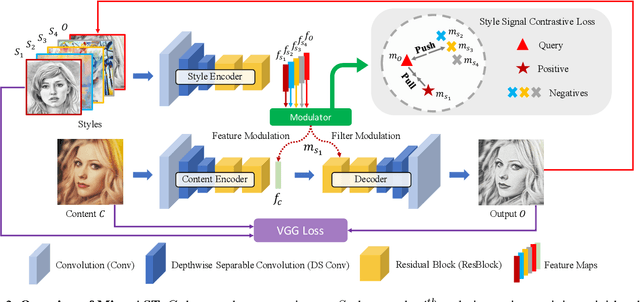

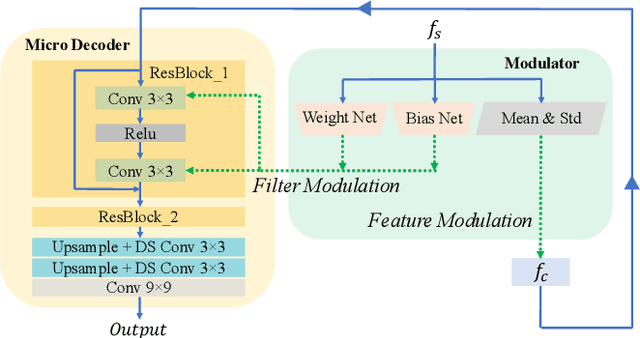
Abstract:Arbitrary style transfer (AST) transfers arbitrary artistic styles onto content images. Despite the recent rapid progress, existing AST methods are either incapable or too slow to run at ultra-resolutions (e.g., 4K) with limited resources, which heavily hinders their further applications. In this paper, we tackle this dilemma by learning a straightforward and lightweight model, dubbed MicroAST. The key insight is to completely abandon the use of cumbersome pre-trained Deep Convolutional Neural Networks (e.g., VGG) at inference. Instead, we design two micro encoders (content and style encoders) and one micro decoder for style transfer. The content encoder aims at extracting the main structure of the content image. The style encoder, coupled with a modulator, encodes the style image into learnable dual-modulation signals that modulate both intermediate features and convolutional filters of the decoder, thus injecting more sophisticated and flexible style signals to guide the stylizations. In addition, to boost the ability of the style encoder to extract more distinct and representative style signals, we also introduce a new style signal contrastive loss in our model. Compared to the state of the art, our MicroAST not only produces visually superior results but also is 5-73 times smaller and 6-18 times faster, for the first time enabling super-fast (about 0.5 seconds) AST at 4K ultra-resolutions. Code is available at https://github.com/EndyWon/MicroAST.
AesUST: Towards Aesthetic-Enhanced Universal Style Transfer
Aug 27, 2022



Abstract:Recent studies have shown remarkable success in universal style transfer which transfers arbitrary visual styles to content images. However, existing approaches suffer from the aesthetic-unrealistic problem that introduces disharmonious patterns and evident artifacts, making the results easy to spot from real paintings. To address this limitation, we propose AesUST, a novel Aesthetic-enhanced Universal Style Transfer approach that can generate aesthetically more realistic and pleasing results for arbitrary styles. Specifically, our approach introduces an aesthetic discriminator to learn the universal human-delightful aesthetic features from a large corpus of artist-created paintings. Then, the aesthetic features are incorporated to enhance the style transfer process via a novel Aesthetic-aware Style-Attention (AesSA) module. Such an AesSA module enables our AesUST to efficiently and flexibly integrate the style patterns according to the global aesthetic channel distribution of the style image and the local semantic spatial distribution of the content image. Moreover, we also develop a new two-stage transfer training strategy with two aesthetic regularizations to train our model more effectively, further improving stylization performance. Extensive experiments and user studies demonstrate that our approach synthesizes aesthetically more harmonious and realistic results than state of the art, greatly narrowing the disparity with real artist-created paintings. Our code is available at https://github.com/EndyWon/AesUST.
Texture Reformer: Towards Fast and Universal Interactive Texture Transfer
Dec 06, 2021
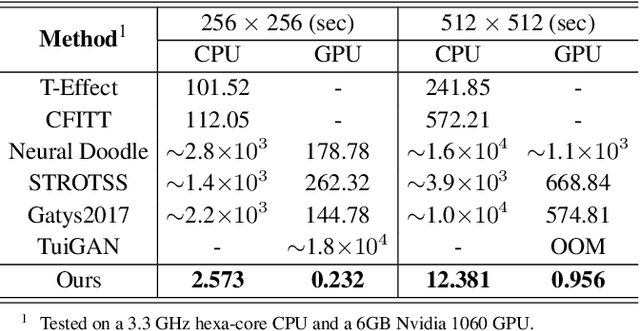
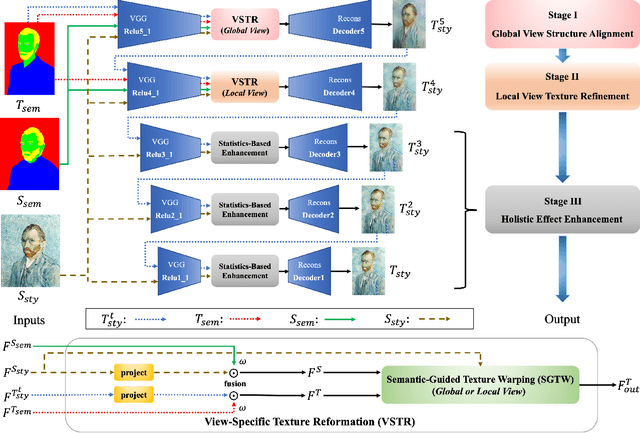

Abstract:In this paper, we present the texture reformer, a fast and universal neural-based framework for interactive texture transfer with user-specified guidance. The challenges lie in three aspects: 1) the diversity of tasks, 2) the simplicity of guidance maps, and 3) the execution efficiency. To address these challenges, our key idea is to use a novel feed-forward multi-view and multi-stage synthesis procedure consisting of I) a global view structure alignment stage, II) a local view texture refinement stage, and III) a holistic effect enhancement stage to synthesize high-quality results with coherent structures and fine texture details in a coarse-to-fine fashion. In addition, we also introduce a novel learning-free view-specific texture reformation (VSTR) operation with a new semantic map guidance strategy to achieve more accurate semantic-guided and structure-preserved texture transfer. The experimental results on a variety of application scenarios demonstrate the effectiveness and superiority of our framework. And compared with the state-of-the-art interactive texture transfer algorithms, it not only achieves higher quality results but, more remarkably, also is 2-5 orders of magnitude faster. Code is available at https://github.com/EndyWon/Texture-Reformer.
Diversified Patch-based Style Transfer with Shifted Style Normalization
Jan 16, 2021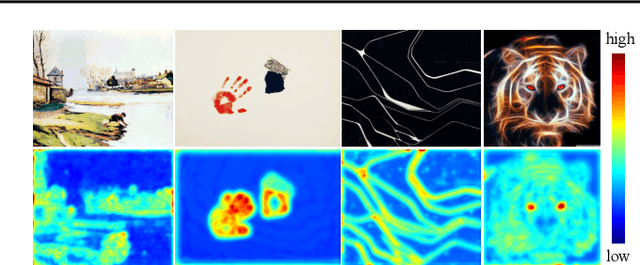
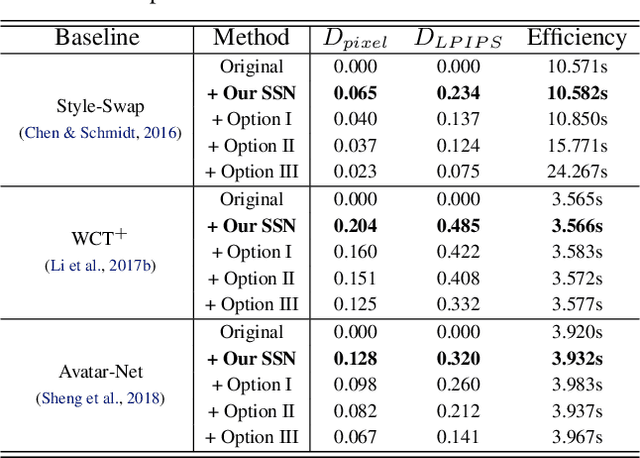

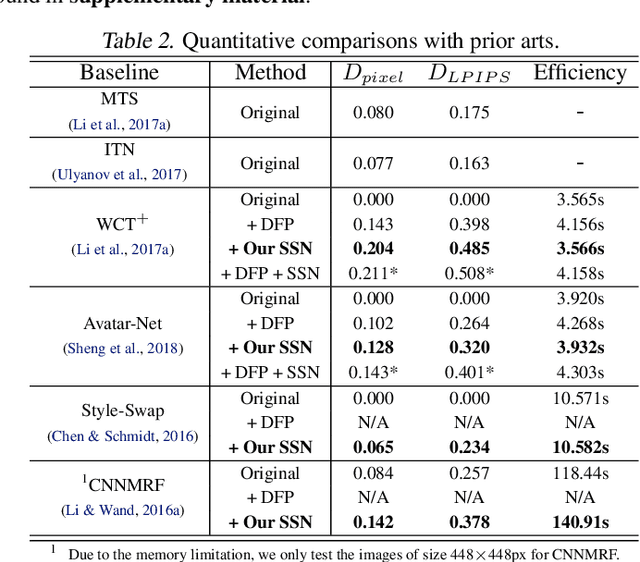
Abstract:Gram-based and patch-based approaches are two important research lines of image style transfer. Recent diversified Gram-based methods have been able to produce multiple and diverse reasonable solutions for the same content and style inputs. However, as another popular research interest, the diversity of patch-based methods remains challenging due to the stereotyped style swapping process based on nearest patch matching. To resolve this dilemma, in this paper, we dive into the core style swapping process of patch-based style transfer and explore possible ways to diversify it. What stands out is an operation called shifted style normalization (SSN), the most effective and efficient way to empower existing patch-based methods to generate diverse results for arbitrary styles. The key insight is to use an important intuition that neural patches with higher activation values could contribute more to diversity. Theoretical analyses and extensive experiments are conducted to demonstrate the effectiveness of our method, and compared with other possible options and state-of-the-art algorithms, it shows remarkable superiority in both diversity and efficiency.
Multimodal Image-to-Image Translation via Mutual Information Estimation and Maximization
Sep 06, 2020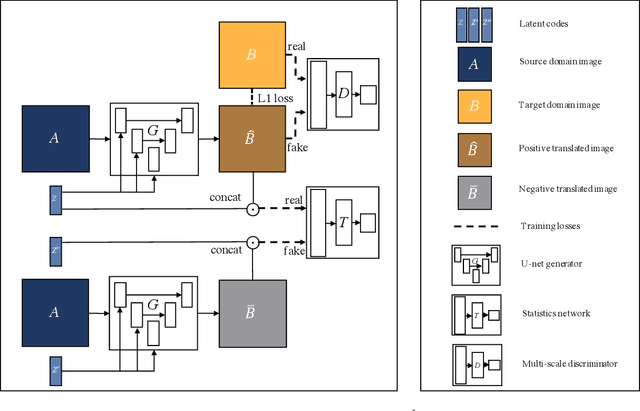



Abstract:In this paper, we present a novel framework that can achieve multimodal image-to-image translation by simply encouraging the statistical dependence between the latent code and the output image in conditional generative adversarial networks. In addition, by incorporating a U-net generator into our framework, our method only needs to learn a one-sided translation model from the source image domain to the target image domain for both supervised and unsupervised multimodal image-to-image translation. Furthermore, our method also achieves disentanglement between the source domain content and the target domain style for free. We conduct experiments under supervised and unsupervised settings on various benchmark image-to-image translation datasets compared with the state-of-the-art methods, showing the effectiveness and simplicity of our method to achieve multimodal and high-quality results.
On Compression of Unsupervised Neural Nets by Pruning Weak Connections
Jan 23, 2019



Abstract:Unsupervised neural nets such as Restricted Boltzmann Machines(RBMs) and Deep Belif Networks(DBNs), are powerful in automatic feature extraction,unsupervised weight initialization and density estimation. In this paper,we demonstrate that the parameters of these neural nets can be dramatically reduced without affecting their performance. We describe a method to reduce the parameters required by RBM which is the basic building block for deep architectures. Further we propose an unsupervised sparse deep architectures selection algorithm to form sparse deep neural networks.Experimental results show that there is virtually no loss in either generative or discriminative performance.
 Add to Chrome
Add to Chrome Add to Firefox
Add to Firefox Add to Edge
Add to Edge